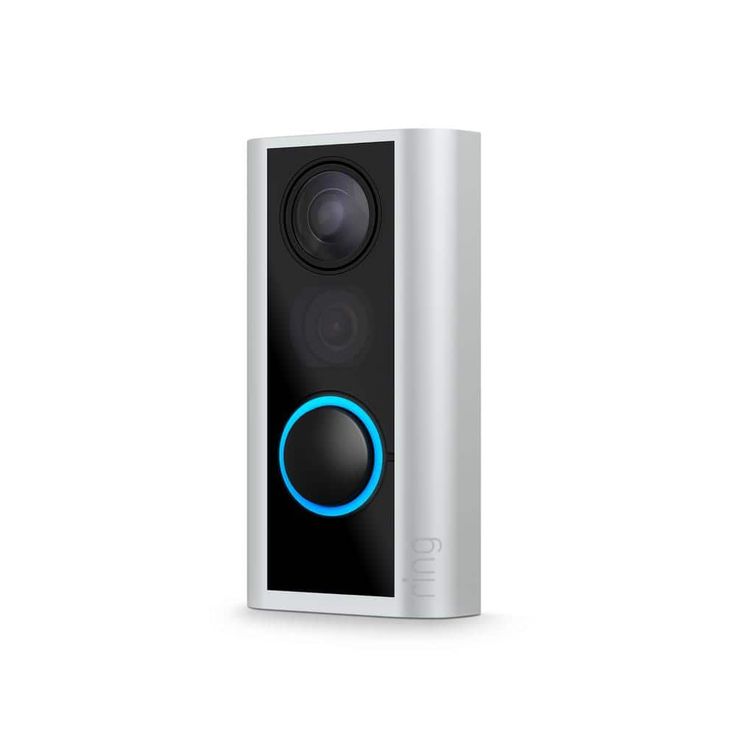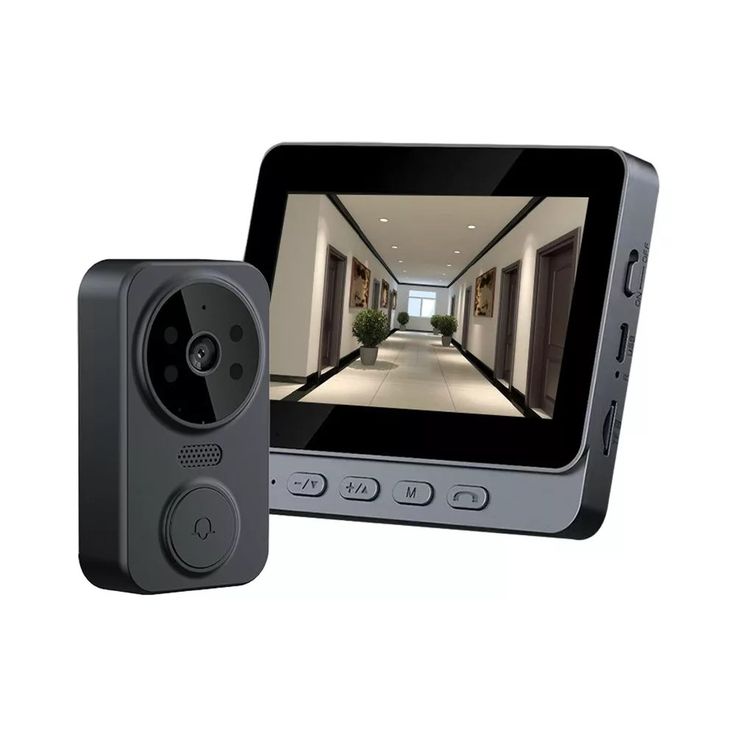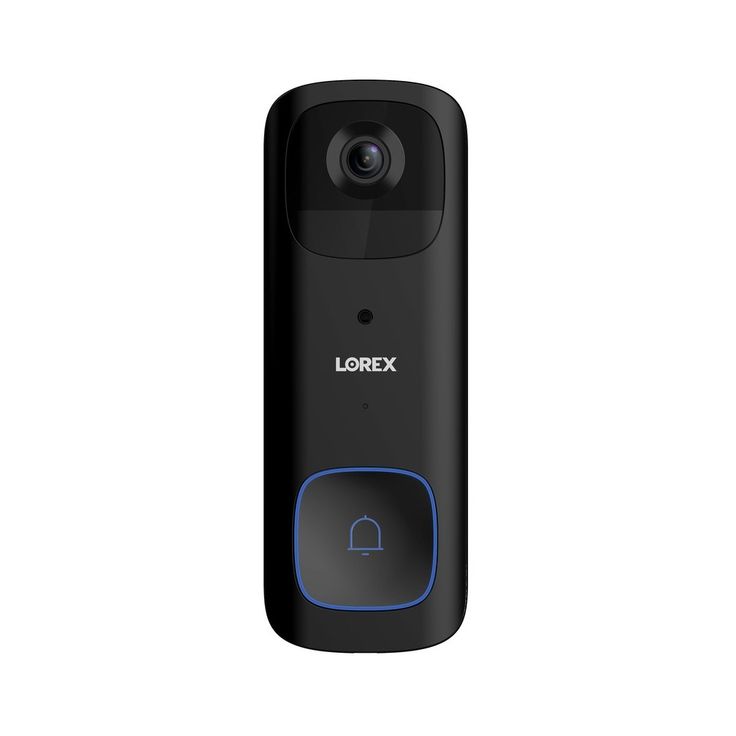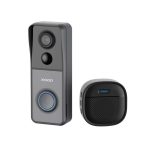The Evolution of Doorbells and the Rise of Wireless Technology
The humble doorbell has come a long way. What began as a simpl knock e bell has evolved into an advanced wireless doorbell system. Let’s look at this evolution.
Years ago, a visitor announced their arrival with a knock. Later, mechanical doorbells using a pull cord emerged. Electricity brought push-button doorbells. These needed wires lines inside walls.
Wireless doorbells began appearing with technological advancements. They removed the need for complex wiring. Now, homes could have doorbells without altering the structure.
The rise of wireless technology was a game-changer. It combined convenience and functionality. Wireless doorbells became popular quickly. They offered easy installation and reliability. Users began to expect more from wireless doorbells as technology progressed.

Key Features of Modern Wireless Doorbells
As wireless doorbell systems evolve, their features become more innovative and user-friendly. Modern wireless doorbells now include options that enhance convenience, security, and connectivity. Let’s dive into some of the standout features that define today’s wireless doorbell models.
Video Monitoring and Smart Connectivity
One of the most appealing additions to modern wireless doorbells is video monitoring. This feature allows homeowners to see who is at the door without opening it. High-definition cameras provide clear visuals, while night vision capabilities ensure 24/7 effectiveness.
Smart connectivity furthers the utility of video monitoring. It lets users connect their wireless doorbell to mobile apps or smart home systems. This integration allows for real-time video streaming and communication with visitors from anywhere.
Motion Detection and Alerting Systems
Motion detection is another critical feature in newer wireless doorbells. It uses sensors to detect movement near the door. Upon detection, the system alerts homeowners through their connected devices. This alert can be via sound, a phone notification, or both.
This feature not only enhances security by informing about potential intruders but also helps in greeting guests promptly. The sensitivity of the motion detectors can often be adjusted to minimize false alarms caused by pets or passing cars.
Installation and Maintenance of Wireless Doorbells
Installing a wireless doorbell is often surprisingly simple. Most systems require no special tools or extensive knowledge. Here’s a step-by-step guide to the installation process:
- Choose the right location for your doorbell. It should be within range of your wireless receiver.
- Mount the doorbell transmitter. It typically involves attaching it with screws or adhesive tape.
- Install the receiver in a power outlet inside your home. Make sure it’s in a location where you can hear it.
- Pair the transmitter with the receiver, following the manufacturer’s instructions.
- Test the doorbell to ensure it’s functioning correctly. Adjust the volume or location if necessary.
Maintenance of wireless doorbells is also straightforward. Here are some tips to keep your device working well:
- Regularly check batteries if your model is battery-powered. Replace them as needed.
- Keep the doorbell clean. Wipe the exterior parts with a dry cloth to remove dust and debris.
- Test the signal and range occasionally to confirm uninterrupted service.
- Follow any manufacturer-specific guidance provided in the user manual.
Remember, the key is to maintain the wireless doorbell’s functionality to ensure security and convenience remain uncompromised.

Comparing Wired and Wireless Doorbells: Pros and Cons
When deciding between wired and wireless doorbell systems, it’s essential to weigh their advantages and disadvantages. This comparison will help you choose a doorbell that meets your needs in terms of installation, maintenance, and performance.
Pros of Wired Doorbells:
- Reliability: Wired doorbells have a direct power connection, which often leads to fewer signal interruptions.
- No Batteries Needed: They don’t require battery replacements, cutting down on maintenance.
- Traditional: Some people prefer the classic look and feel of wired doorbells.
Cons of Wired Doorbells:
- Complex Installation: Installing wired doorbells can require drilling and electrical work, making them less ideal for renters.
- Limited Flexibility: Moving a wired doorbell is tough since it’s connected to the home’s wiring.
Pros of Wireless Doorbells:
- Easy Installation: Wireless doorbells can be set up quickly, without the need for professional help.
- Portability: They can be placed anywhere within range of the receiver, offering greater flexibility.
- Advanced Features: Many wireless doorbells come with modern features like video monitoring and smart connectivity.
Cons of Wireless Doorbells:
- Battery Dependence: Some models require battery changes, which means keeping an eye on battery life.
- Signal Interference: Occasionally, other wireless devices can interfere with the doorbell’s signal.
Ultimately, the choice between wired and wireless doorbells hinges on personal preference and home needs. Wireless doorbells are often the go-to for their convenience and advanced technology, but there’s still a place for wired doorbells in many homes.
How Wireless Doorbells Enhance Home Security
Wireless doorbells are no longer just about hearing a chime when someone is at the door. They now play a significant role in bolstering home security through various advanced features. These devices leverage the latest technology to inform, alert and integrate seamlessly with overall home security systems.
Real-Time Notifications and Remote Access
One of the standout features of modern wireless doorbells is the ability to send real-time notifications. When someone presses the doorbell or even approaches the door, the system can notify homeowners instantly on their smartphones. This feature is incredibly beneficial for maintaining security when away from home. Additionally, remote access through smartphone apps allows homeowners to communicate with visitors directly, no matter their location. This not only increases security but also enhances convenience, providing peace of mind to the homeowner.
Integration with Smart Home Ecosystems
Wireless doorbells easily integrate with existing smart home ecosystems. This compatibility means that they can work in tandem with other smart devices in the home, such as locks, lights, and security systems. For example, when the doorbell detects someone at the door, it can trigger the home’s smart lights to turn on, potentially deterring unwanted visitors. Moreover, integration with smart security systems can allow for features like automatic recording or alerting local authorities in case of suspicious activity. This unified approach to home security makes wireless doorbells an integral part of any modern smart home.

Wireless Doorbell Power Options: Battery vs. Rechargeable
When choosing a wireless doorbell, one of the key considerations is the power source. Wireless doorbells typically rely on either traditional batteries or rechargeable power options. Understanding the differences between these two can guide you in selecting the right wireless doorbell system for your home.
Battery-Powered Wireless Doorbells:
- Convenience: Battery-powered doorbells are easy to install with no need for wiring.
- Placement Flexibility: They can be placed almost anywhere, as long as it’s within the receiver’s range.
- Maintenance: Regular battery changes are necessary, which can be a minor inconvenience.
Battery-powered doorbells use common battery types like AA or AAA, making them readily available. However, they may not be the best choice for those who prefer a set-and-forget system due to the ongoing need to check and replace batteries.
Rechargeable Wireless Doorbells:
- Eco-Friendly: Rechargeable doorbells reduce waste by eliminating the need for disposable batteries.
- Cost-Efficient: Over time, rechargeability can save money as it avoids the constant purchase of new batteries.
- Continuous Power: Some rechargeable doorbells come with backup power options, ensuring they work during power outages.
Rechargeable wireless doorbells might require less frequent attention than battery-powered models, but they do need to be recharged at intervals. This is a small trade-off for a more sustainable power solution and potentially fewer interruptions in service.
Overall, the choice between battery-powered and rechargeable wireless doorbells comes down to personal preference and lifestyle. For those who prioritize low maintenance, rechargeable doorbells might be the better option. Conversely, battery-powered doorbells provide ease of use and simple installation – appealing for users who don’t mind the occasional battery replacement.
In summary, both options have their merits, and the decision should align with your home security needs and convenience preferences.
Selecting the Right Wireless Doorbell for Your Home
Selecting the ideal wireless doorbell involves considering compatibility, range, and aesthetics. These factors influence the performance and look of your doorbell system.
Compatibility, Range, and Aesthetics
When choosing a wireless doorbell, ensure it’s compatible with your existing devices. This means checking if it works with your smartphone or smart home systems. The range of the doorbell is also crucial. It must reach every corner of your home for effective use. Lastly, consider the doorbell’s design. Pick one that complements your home’s style.
- Compatibility: Check for integration with smart devices.
- Range: Ensure the doorbell covers your entire home.
- Aesthetics: Choose a style that matches your home.
Brand Comparisons and Consumer Reviews
Researching brands and reading reviews is a smart move. Look for brands with a solid reputation for reliability and customer service. Online consumer reviews can offer real insight into a product’s performance. Pay attention to comments about battery life, ease of installation, and feature effectiveness.
- Brand Reputation: Consider trusted brands in the wireless doorbell market.
- Consumer Reviews: Read reviews for user experiences.
- Feature Evaluation: Focus on reviews discussing battery life and ease of installation.
Future Trends in Wireless Doorbell Technology and Home Security
The future of wireless doorbell technology is promising and ever-evolving. Innovation in this field aims to further enhance home security, adding features that bring greater peace of mind to homeowners. Here’s what we can anticipate:
- Advanced Video Analytics: Future wireless doorbells may offer sophisticated analytics. This includes facial recognition to distinguish between known visitors and strangers.
- Enhanced Integration: Doorbell systems will integrate more deeply with smart homes. Expect seamless automation across multiple devices for improved security and convenience.
- Solar Power Options: Eco-friendly solar-powered doorbells might become common. They’ll offer sustainable power without the need for battery changes or electrical charging.
- AI-powered Surveillance: Artificial Intelligence could be used to analyze real-time video feeds. It will alert homeowners to unusual activity, not just the presence of a person.
- Improved Connectivity: Anticipate stronger and more stable wireless connections. This ensures your doorbell is always connected and functional, even with broader smart home systems.
- Customizable Alert Profiles: Users might be able to create personalized alert settings. This includes silent modes or alarms for specific types of visitors or times of the day.
As technology advances, so does the potential for new security solutions. Wireless doorbell manufacturers will likely incorporate these technologies into future models. They’ll provide homeowners with innovative tools to safeguard their residences.
In this evolving landscape, the wireless doorbell not only becomes a point of entry communication but a pivotal component of a comprehensive home security system. The goal is clear: to better protect homes with a blend of simplicity, efficiency, and smart technology. For anyone investing in home security, staying abreast of these trends is essential. It ensures that your home is equipped with the latest, cutting-edge technology available.

